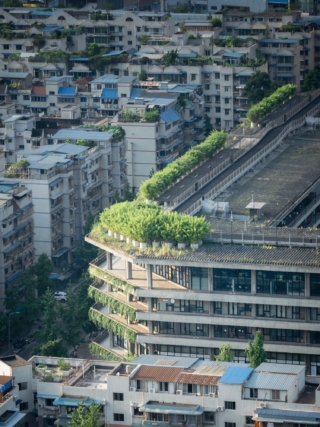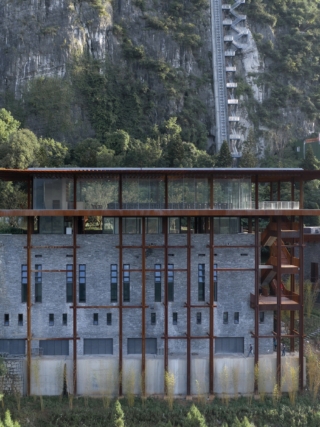Chinese architect Liu Jiakun’s work redefines urban space by embracing tradition, fostering community, and honouring everyday life.
The Renovation of Tianbao Cave District of Erlang Town. (Credit: Arch-Exist 2)
The 2025 Pritzker Architecture Prize has been awarded to Liu Jiakun, a Chengdu-based architect renowned for his deeply rooted and socially responsive designs. According to the jury, Liu’s work exemplifies an architecture that is unpretentious yet profound, responding to cultural narratives, community needs, and material honesty. His buildings do not impose; rather, they emerge from their context, subtly shaping the lives of those who interact with them.
Liu Jiakun. (Credit: The Hyatt Foundation: The Pritzker Architecture Prize)
Liu Jiakun’s architectural ethos is one of mediation—between tradition and modernity, utopia and reality, the collective and the individual. His projects avoid rigid stylistic imposition, instead adopting a design methodology that responds to each site’s unique characteristics. As the Pritzker Jury notes, his work “imagines and constructs new worlds, free from any aesthetic or stylistic constraint.”
This philosophy is exemplified in projects like West Village (Chengdu, 2015), a five-storey, mixed-use development that reinterprets urban density. Instead of the conventional vertical expansion seen in high-rise developments, Liu introduces an interconnected network of spaces for culture, business, and leisure. The project fosters a relationship between open and enclosed spaces, promoting community interaction rather than isolation.
West Village. (Credit: Chen Chen. Photos below courtesy of Arch-Exist, Transmedia Co., Chen Chen, Li Ziquiang and Shen Photography)
One of Liu’s most remarkable qualities is his ability to elevate the everyday. Unlike others who engage with architecture as a medium of spectacle, Liu finds beauty in the ordinary. He reinterprets vernacular materials and traditional techniques, ensuring that his designs remain accessible and meaningful to local communities.
His work on the Shuijingfang Museum (Chengdu, 2013) illustrates this approach. Rather than creating a detached monument to history, Liu integrates the museum within its surroundings, using locally sourced materials that honour the traditional Chinese courtyard typology. Similarly, his design for the Suzhou Museum of Imperial Kiln Brick (Suzhou, 2016) subtly references ancient craftsmanship, connecting contemporary audiences with historical narratives through spatial experience.
Shuijingfang Museum. (Credit: Arch-Exist. Photos below courtesy of Arch-Exist, Chin Hyosook and Jiakun Architects)
Liu’s projects are often shaped by collective memory, too. His design for the Hu Huishan Memorial (Chengdu, 2009) stands as a poignant example. Constructed after the devastating 2008 Wenchuan earthquake, the memorial is a simple yet powerful concrete relief tent, commemorating both an individual tragedy and a shared national loss. His innovative “Rebirth Bricks,” made from earthquake rubble reinforced with wheat fibre and cement, embody a philosophy of resilience—both material and emotional.
This sensitivity extends to the transformation of existing environments. The Renovation of Tianbao Cave District (Luzhou, 2021) is an example of Liu’s ability to weave architecture into nature, embedding new structures within the rugged mountain terrain rather than imposing upon it. His work respects both the land and the stories it holds, reinforcing the continuity between past and present.
The Renovation of Tianbao Cave District of Erlang Town. (Above and photos below credit: Arch-Exist)
In a world where rapid urbanisation often leads to homogenised environments, Liu’s work is a reminder that architecture should be deeply personal, rooted in place, and reflective of those who inhabit it.
“Liu Jiakun uplifts through the process and purpose of architecture, fostering emotional connections that unite communities,” said Tom Pritzker, chairman of The Hyatt Foundation, which sponsors the award. “There is a wisdom in his architecture, philosophically looking beyond the surface to reveal that history, materials and nature are symbiotic.”
JURY CITATION:
The Pritzker Architecture Prize is conferred in acknowledgment of those qualities of talent, vision, and commitment, which have persistently produced significant contributions to humanity and the built environment through the art of architecture.
In a global context where architecture is struggling to find adequate responses to fast evolving social and environmental challenges, Liu Jiakun has provided convincing answers that also celebrate the everyday lives of people as well as their communal and spiritual identities.
Through an outstanding body of work of deep coherence and constant quality, Liu Jiakun imagines and constructs new worlds, free from any aesthetic or stylistic constraint. Instead of a style, he has developed a strategy that never relies on a recurring method but rather on evaluating the specific characteristics and requirements of each project differently. That is to say, Liu Jiakun takes present realities and handles them to the point of offering a whole new scenario of daily life. Beyond knowledge and technique, he adds common sense and wisdom to the designer’s toolbox.
The built environment is often being pulled in opposite directions. While density appears to be a more sustainable solution for people to live together, the scarcity of space usually implies a poor quality of life. Liu Jiakun rethinks the fundamentals of density through cohabitation, crafting an intelligent solution that balances the opposite forces at play. Through transformative projects like the West Village in Chengdu, he reshapes the paradigm of public spaces and of community life. He invents new independent, shared ways of living together in which density does not represent the opposite of an open system. He also enables adaptation, expansion and replicability. Liu Jiakun enhances and welcomes the life that inhabitants bring to his projects, creating an architecture activated by its publics.
In Liu Jiakun’s work, identity is as much about the individual as it is about the collective sense of belonging to a place. He revisits the Chinese tradition as a springboard for innovation devoid of nostalgia or ambiguity. For him, identity refers to a country’s history, the traces of its cities and the relics of its communities. At the same time, he integrates the local and global dimensions with unprecedented results. In his subtle, memorable museums, Suzhou Museum of Imperial Kiln Brick or the Shuijingfang Museum in Chengdu, he creates new architecture that is at once a historical record, a piece of infrastructure, a landscape, and a remarkable public space. In the Hu Huishan Memorial in Chengdu, he understands that identity is a matter of both collective and personal memory, brilliantly elevating the individual perspective to a foundational element of place-making in order to revive a communal dimension.
Museum of Clocks, Jianchuan Museum Cluster. (Credit: Bi Kejian. Photos below courtesy of Arch-Exist)












































